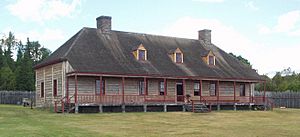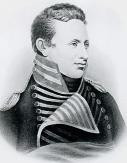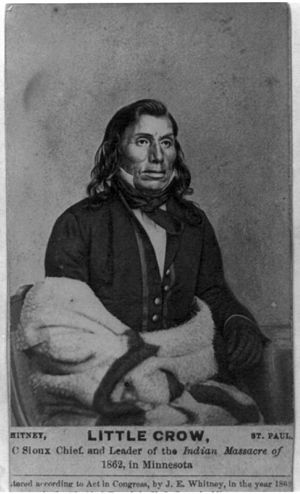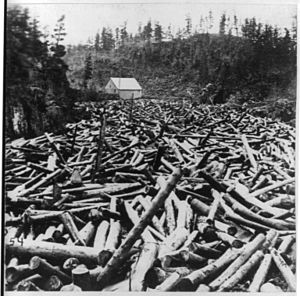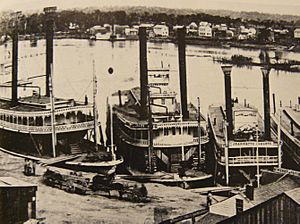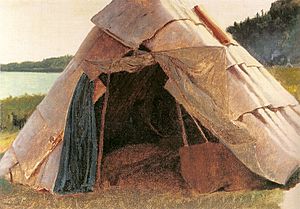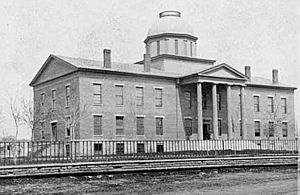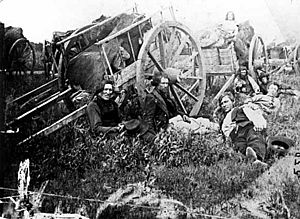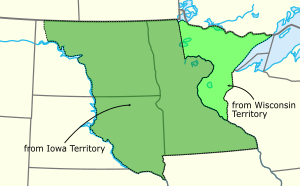Territorial era of Minnesota facts for kids

Fort Snelling in 1844, by John Caspar Wild
|
|
| Date | 1803–1858 |
|---|---|
| Location | Midwestern United States |
The territorial era of Minnesota was a time when the area that is now Minnesota was not yet a state. It started in 1803 with the Louisiana Purchase. This period ended in 1858 when Minnesota officially became a state. The Minnesota Territory itself was created in 1849. But the land had a long and interesting story even before that.
Europeans had been in this area for a long time. But in the 1800s, the United States really started to take control. Many things people think of as "early Minnesota" actually happened later. For example, many people from Scandinavia moved here after 1858. The stories by author Laura Ingalls Wilder also happened later. The early 1800s were different. There were fewer people, life was tough, and rules were not always clear.
This time was also a big change for the economy. For centuries, the fur trade was the main business. Native American tribes like the Dakota Sioux and Ojibwe hunted animals. They traded furs with French, British, and American traders. Important trading spots included Grand Portage and Mendota. But the demand for furs in Europe slowly went down.
Then, the lumber industry grew very fast. It became the most important business. Later, growing grain also started to become a big part of the economy. Sawmills and grain mills near Fort Snelling and Saint Anthony Falls became popular places. By the end of this era, central Minnesota was the main economic hub.
This era also saw big cultural changes. When the U.S. took over, Native Americans were the largest group. Their role in the fur trade gave them money and power. French and British traders had lived peacefully with Native Americans for decades. They even created new groups of mixed-race people. But as Americans arrived and the fur trade slowed, things changed. Native Americans lost some of their economic power. More and more people from Europe moved in during the 1850s. The population quickly changed from mostly Native American to mostly European. Even so, Native American and mixed-race people still influenced the territory's culture. Many people from New England and New York moved to Minnesota. This led to Minnesota being called the "New England of the West."
Contents
- Exploring Early Minnesota
- How the U.S. Acquired Minnesota Lands
- Early American Explorers and Settlers
- Building Forts in Minnesota
- Native American Life and Changes
- Growing Businesses and Trade
- Growing Towns and Communities
- Society and Culture
- African Americans and Slavery
- Government and Becoming a State
- Becoming a State
- Minnesota in Popular Culture
Exploring Early Minnesota
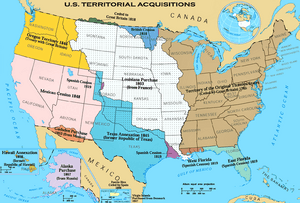
In the 1600s, the Ojibwe tribe moved west and reached Minnesota. They knew how to trade with Europeans. Tensions grew between the Ojibwe and the Santee Sioux. The Sioux were already the main tribe in the area.
French explorers came to Minnesota in the 1600s. Some famous ones were Radisson and Groseilliers. France made a deal with tribes to allow trade. Then, French settlements started to appear. Trader Daniel Greysolon, Sieur du Lhut explored near Lake Superior. This helped trade and led to Fond du Lac being built. This area is now part of Duluth.
A French priest named Louis Hennepin explored in 1680. The Sioux captured him. He discovered and named Saint Anthony Falls. Later, Captain Jonathan Carver from Connecticut reached Saint Anthony Falls in 1766. In the late 1700s, trader Peter Pond explored the Minnesota River valley. He saw many European settlements there, along with Native Americans.
Explorers kept looking for the famous Northwest Passage. They also searched for large inland seas in North America. Fort Beauharnois was built by the French in 1721. It was on Lake Pepin to help with exploration. In the 1600s, a rich fur trade began. Native Americans trapped animals near the Great Lakes. Traders sent the furs to Europe. This trade was the main way people made money for 200 years.
A special group called the Métis people came from this trade. They were mixed-race people, often with Native American and French backgrounds. In the late 1700s, many French and English traders married Sioux women. This helped them build good relationships with the Sioux. It also helped them get furs from the tribes.
The British Hudson's Bay Company started in 1670. They wanted to profit from the fur trade near Hudson Bay. This company became very powerful in the 1700s. The North West Company of Montreal started in 1779. They wanted to compete with Hudson's Bay Company. They set up their main trading spot at Grand Portage in Minnesota. Grand Portage became a major British fur trading post.
British ships regularly crossed Lake Superior. They brought supplies and took back furs. Even after Grand Portage became U.S. property in 1783, British companies kept trading there for a while.
Different parts of Minnesota were claimed by Spain, France, and Britain. But none of these countries built many large settlements. The French and British mostly set up trading posts. They relied on Native Americans to supply furs.
How the U.S. Acquired Minnesota Lands
The land east of the Mississippi River was given to the United States in 1783. This happened after the American Revolution with the Second Treaty of Paris. This included what is now Saint Paul. But it was only part of Minneapolis and some eastern and northern parts of the state. The treaty used old maps from fur traders. These maps were not always correct. Many states claimed parts of this region. They later gave these lands to the U.S. government.
Most of the rest of Minnesota was bought from France in 1803. This was part of the Louisiana Purchase. The land west of the Mississippi had just been bought by France from Spain. Some northern parts of Minnesota were in Rupert's Land. This was a large area owned by the Hudson's Bay Company. The exact border between Minnesota and British North America was decided later. This happened with the Anglo-American Convention of 1818.
Until 1818, the entire Red River Valley was considered British. This area is now in southeastern Manitoba and northwestern Minnesota. The Hudson's Bay Company tried to settle this area. The Red River Colony was set up in 1811. But Métis people had lived in the valley since the mid-1600s. The Red River Colony had many problems. But it was important for the early fur trade in Minnesota. It also supplied many early settlers to the region.
Early American Explorers and Settlers
By the early 1800s, many parts of Minnesota were already known to British and French explorers. Most people in the region were Native American. But there were also important British trading posts. Many European and mixed-race settlers lived there, especially in the north. Grand Portage was a major trading center for the North West Company.
David Thompson, a British fur trader, made many maps of North America. In 1797, he made the first known map of the Minnesota area. But the Jay Treaty made most British settlers leave their settlements in 1796. However, mixed-race people stayed.
In 1805, U.S. Lieutenant Zebulon Pike was sent to Minnesota. He was ordered to show that the U.S. was in charge. He also needed to make friends and trade with Native American tribes. He met with Sioux leaders in central Minnesota. He wanted to get land rights near Saint Anthony Falls. This area would later become Saint Paul. Some Sioux leaders signed a treaty. But it's unclear if they fully understood it. Pike's efforts did not fully establish U.S. power in the area.
In 1817, Major Stephen Harriman Long led an expedition. He traveled by boat from Prairie du Chien to Saint Anthony Falls. He wrote about the land where Minneapolis and Saint Paul are now. He also described the Native American villages there.
In 1818, the 49th parallel became the border between the U.S. and British North America. But the exact spot where the Red River crossed this line was not marked until 1823. Stephen Long led another expedition to survey it. They found that the fur trading post of Pembina was just inside the U.S. border.
People also tried to find where the Mississippi River started. In 1823, Italian explorer Giacomo Beltrami thought he found the source at Lake Julia. But the real source was found in 1832. Henry Schoolcraft was guided by Ojibwe people, led by Ozaawindib. They found a lake in northern Minnesota. Schoolcraft named it Lake Itasca. This name combines Latin words for "truth" and "head."
In 1835, George William Featherstonhaugh studied the Minnesota River valley. He wrote a book about his canoe trip. Joseph Nicollet explored the area in the late 1830s. He mapped the Upper Mississippi River basin and other rivers.
Building Forts in Minnesota
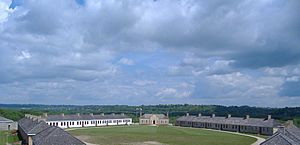
An important part of life on the frontier was the system of forts. These were built by the military. Forts gave soldiers and explorers safe places to stay. They were also bases for military and trade trips. The first forts in the area were French. Fort Beauharnois was built in the 1700s. It was later left empty because of the French and Indian War. British Fort Charlotte at Grand Portage was vital for the fur trade. It protected and supplied British traders and Native Americans. This British fort operated there until 1803, even though it was U.S. land. Other French and British forts had existed but were abandoned earlier.
In 1814, the U.S. government built Fort Shelby. It was later rebuilt as Fort Crawford in Wisconsin. Fort Crawford was important for U.S. activities in Minnesota. It was where the First Treaty of Prairie du Chien was signed. The first major U.S. military base in modern Minnesota was Fort Saint Anthony. It was later renamed Fort Snelling. It was named after its commander, Josiah Snelling.
The land for Fort Snelling was bought in 1805 by explorer Zebulon Pike. People were worried about the fur trade in the area. So, construction of the fort began in 1819 and finished in 1825. One of the fort's jobs was to help settle arguments between the Ojibwe and Dakota tribes. Lawrence Taliaferro, a U.S. agent for Native American affairs, worked at the fort for 20 years. He was important in these talks.
Fort Ripley was built in 1848–1849. It was in central Minnesota near Little Falls. It provided a military presence near the new Winnebago reservation. It also helped keep peace between the Dakota Sioux and the Ojibwe.
Fort Ridgely was built in 1853–1854. It was near the Dakota reservation in southwestern Minnesota. It was named by U.S. Secretary of War Jefferson Davis. The fort watched over the Minnesota River Valley. It was a military post until 1867.
Fort Abercrombie was built in 1858 on the Red River. This is now the border between Minnesota and North Dakota. The fort had to be moved later because of floods. It was built to encourage settlement in the Red River Valley. It also protected steamboat traffic and wagon trains going to Montana.
Besides military bases, private companies had many trading posts. These were often called "forts." But they usually did not have strong defenses.
Native American Life and Changes
-
Native American populations
(1849–1853)Group Sub-group Population (year) Ojibwe Lake Superior 500 (1850) Saint Croix 800 (1850) Mississippi 1,100 (1850) Pillagers 1,050 (1850) Northern/Red Lake 1,200 (1850) Bois Forts 800 (1850) Dakota Sioux Mdewakanton 2,200 (1849) Wahpekute 800 (1849) Wahpetonwan 1,500 (1849) Sisseton 3,800 (1849) Yankton 3,200 (1849) Yanktonai 4,000 (1849) Teton 6,000 (1849) Others Winnebago (Ho-Chunk) 2,500 (1849) Mandan, Hidatsa, Arikara 2,253 (1853)
The two main Native American groups in Minnesota were the Dakota Sioux and the Ojibwe. The Sioux had been there longer. The Ojibwe had moved in more recently. These two groups fought over land in the 1700s. The Battle of Kathio in the mid-1700s was a big Ojibwe victory. It made northeastern Minnesota, especially Mille Lacs Lake, Ojibwe land. The Sioux moved to southern and western Minnesota. Small fights continued in the 1800s.
During the War of 1812, most Dakota and Ojibwe sided with the British. Some helped the Americans or attacked enemy tribes. A notable American supporter was the Dakota chief Tamaha. He admired Pike and joined the U.S. army. Only Grand Portage saw major fighting in Minnesota during the war. But Native Americans from the region were recruited to fight further east.
From 1815 to 1821, the Hudson's Bay Company and the North West Company fought over fur trade areas. This was called the "fur trade wars." As a result, many Métis moved from the Red River area to central and eastern Minnesota. They settled near Saint Paul. This "Red River Exodus" brought many French-speaking people to Minnesota. Métis and other mixed-race groups were often seen as French Canadian "whites."
By the 1820s, animal populations were declining. This led to more competition among tribes for game and furs. Fur prices also dropped a lot in the late 1820s. This made many Sioux hunters poor. The U.S. government wanted tribes to switch from hunting to farming.
Fights between the Sioux and Ojibwe grew worse. The U.S. government tried to help. President Andrew Jackson wanted to make peace with the tribes. Or he wanted to move them so settlers could expand. The First Treaty of Prairie du Chien (1825) set southern Minnesota as Dakota Sioux land. Northern Minnesota and much of Wisconsin were given to the Ojibwe. But the U.S. government did not always enforce the treaty. This made Little Crow say in 1829, "We made peace to please you, but if we are badly off we must blame you for causing us to give up so much of our lands to our enemies."
After a treaty in 1846, the Winnebago tribes from Iowa moved. They went to the Long Prairie reservation in central Minnesota. Because the land was poor, they later moved further south to Blue Earth in 1856. But they had to give up a lot of land.
All the Native American tribes became disappointed with the U.S. government. The government often did not keep its treaty promises. Important leaders included Wabasha and Little Crow for the Dakota Sioux. Flat Mouth and Hole-in-the-Day led the Ojibwe. Winneshiek led the Winnebago. Mixed-race families like the Faribaults and Renvilles helped a lot with treaty talks.
The Treaty of Traverse des Sioux in 1851 gave all the Wahpeton and Sisseton Sioux lands west of the Mississippi to the U.S. The Treaty of Mendota that same year gave the Mdewakanton and Wahpekute Sioux lands in southern Minnesota. They had to move to an area near Morton. But the U.S. changed both treaties later. They removed promises about lands the tribes would keep. Also, much of the money promised was never delivered. Some said it was because of debts the Sioux owed to fur traders.
-
Native American Population by Year Year Dakota Sioux Ojibwe 1805 10,165 1834 8080 1836 5639 1839 5389 1843 4812 1866 7566
Even though Americans wanted land, Minnesota's leaders did not want to remove the Sioux. The U.S. government gave money to the tribes. This money was often used by U.S. settlements. If the tribes left, this income would be lost.
The Sioux became poorer. The U.S. kept breaking treaties. This led to conflict. In 1857, a group of Sioux led by Inkpaduta attacked Spirit Lake, Iowa. They killed many settlers. They also attacked Springfield, Minnesota (now Jackson). In 1862, Sioux groups started the Dakota War of 1862. They were defeated. Many Dakota Sioux were killed in a mass execution in Mankato. This was the largest mass execution in U.S. history. Hundreds more Sioux and settlers died as the Sioux nation was removed from Minnesota.
Growing Businesses and Trade
The fur trade was the most important business early in this era. In the early 1800s, two British companies competed: Hudson's Bay Company and the North West Company. The North West Company used Grand Portage as its main western base. Grand Portage was one of the four main British fur trading and shipping points in North America. After the Treaty of Paris in 1783, British operations at Grand Portage were technically illegal. But trade continued.
However, in 1801, the North West Company moved its headquarters north to Fort William in Ontario. After 1804, Grand Portage became a minor trading center. Most traders eventually left. In 1842, the Hudson Bay Company, which had taken over the North West Company, shipped out the last Ojibwe workers.
Before 1816, most fur trading posts in Minnesota belonged to the North West Company. But by 1821, the American Fur Company, founded by John Jacob Astor, took over most of them. Another important fur shipping point was Fort Frances in the Rainy Lake region. This area was key to waterways for shipping furs to the Atlantic. Both the North West Company and the American Fur Company had posts there. Pembina was also a major trading post for the Hudson's Bay Company. Once it became U.S. land, it was important for U.S. fur trade interests. By 1830, American Fur controlled most of the trade in the U.S. because British companies were excluded.
Starting in the 1820s, a fur trading route developed. It connected the Red River Colony (in Manitoba) to trading posts in Minnesota. These were first at Mendota and later at Saint Paul. This system of ox cart trails became known as the Red River Trails. Métis people used them to avoid the Hudson's Bay Company's fur trade control. This cross-border trade was illegal. But American and British authorities rarely stopped it. The trail system was used most in the mid-1800s.
The fur trade started to decline by the late 1830s. The American Fur Company went bankrupt in 1842. But other companies kept the trade going. As fur trade declined, the lumber industry grew a lot. Areas like the Saint Croix Valley had many valuable white pine trees. New sawmills appeared in Marine and Stillwater. Lumber was usually cut in winter and sent downriver in spring.
In 1848, businessman Franklin Steele built the first private sawmill at Saint Anthony Falls. This started commercial lumbering on the Mississippi River. More sawmills quickly followed. Soon, the Saint Croix and Mississippi Rivers became major routes for lumber. It was sent to Saint Louis and other places.
The first flour mill in Minnesota was built in 1823 at Fort Snelling. It was a lumber mill that was changed. The first private grain mill was built in Washington County. Minneapolis got its first grain mill in 1847. In the 1850s, grain production grew fast. But Minnesota did not export much grain until 1858.
In 1823, the first steamboat, the Virginia, arrived at Fort Snelling. By the 1830s, steamboats regularly traveled the river. Some even carried "pleasure parties." The first railroad to reach the Mississippi (in Illinois) was finished in 1854. This led to many sightseeing trips up the Mississippi into Minnesota. These trips made so many people interested in Minnesota. In 1856, 56,000 tourists visited Saint Paul by steamboat.
In 1849, James Goodhue started the Minnesota Pioneer newspaper in Saint Paul. By the time Minnesota became a state, 89 newspapers had been started. News about Minnesota spread across the U.S. and Europe. Advertisements were used to attract European settlers. These efforts had some success, but became much more successful after statehood.
Saint Anthony, with its beautiful waterfalls, quickly became a tourist spot. The Winslow House, a fancy hotel, was built in 1857. By the late 1860s, Saint Anthony was a popular summer resort.
A major source of money in the territory during the 1850s was U.S. government payments to Native American tribes. These payments were required by earlier treaties. They averaged over $380,000 per year. For comparison, the territory itself received about $120,000 per year for development. Much of the money meant for tribes was used by U.S. settlers. This helped their businesses and communities. These payments were the territory's most important income source. The fur trade was not as profitable, and other exports were still small.
Growing Towns and Communities
-
Population by Year Year U.S. citizens Natives 1848 4,500 1849 4,535 25,000 1850 6,077 1851 7,600 30,400 1853 40,000 31,700 1857 150,000 1860 172,023
For most of this era, Native Americans greatly outnumbered European and U.S. settlers. Important Dakota Sioux settlements included Kaposia, which was in what is now Saint Paul. Significant Ojibwe settlements included Misizaaga'igan (Mille Lacs) and Nagaajiwanaang (Fond du Lac).
When the Minnesota Territory was formed in 1848, Native American settlements were still as large as American ones. Some say the Mandan/Hidatsa village of Like-a-Fishhook in North Dakota was the largest settlement. It had 700 people. In 1849, the total Native American population was over 25,000. This was much more than the 4,535 "white" settlers.
At the start of the 1800s, most European settlements were related to the fur trade. The largest were trading posts built by the North West Company. These included posts at Sandy Lake, Leech Lake, and Fond du Lac. One historian found over 100 fur trading posts in Minnesota before it became a state. Most of these were later taken over by the American Fur Company. In the 1820s, hundreds of settlers left the Red River Colony. They came into the U.S. through the Red River Valley. This added to Minnesota's population.
Construction on Fort Snelling started in 1820 and finished in 1825. The Fort attracted settlers to east-central Minnesota. Nearby Mendota was also established then. It was the main office for the American Fur Company. This also drew settlers and soon became Minnesota's business center. Many of the first stone buildings were built in Mendota by American Fur Company workers.
The logging industry helped settlements grow. Before railroads, lumbermen used rivers to transport logs. This made Minnesota's timber valuable. Towns like Marine on Saint Croix and Stillwater became important lumber centers. They were supplied by the Saint Croix River. Winona got lumber from southern Minnesota and the Mississippi and Minnesota Rivers.
In the 1830s, a group of squatters settled near Fort Snelling. Most were Métis from the Red River Colony. Because of complaints, they had to move down the Mississippi River. Pierre Parrant, who ran a saloon, set up his business at the new site. The settlers named their place "Pig's Eye" after him. Later, they changed the name to Lambert's Landing, and then Saint Paul. This spot was good for steamboats. By 1847, a steamboat line made it a regular stop. This helped the settlement grow a lot. It soon became more important than Mendota.
Franklin Steele, who ran a general store at Fort Snelling, claimed land near Saint Anthony Falls. This was after the Ojibwe treaty of 1837. In 1848, he built a sawmill at the falls. This started the town of Saint Anthony. John H. Stevens, an employee of Steele, saw that the west side of the falls would be good for mills. This land was still a military area. Stevens made a deal with Fort Snelling's commander. He would provide free ferry service. In return, he got 160 acres of land at the falls. Stevens built the first house in Minneapolis there in 1850. In 1854, Stevens planned the city of Minneapolis on the west bank. In 1855, the first bridge across the main channel of the Mississippi was built. It connected Minneapolis and Saint Anthony.
By 1851, treaties with Native American tribes opened much of Minnesota to U.S. settlement. Fort Snelling was no longer a frontier outpost. Leaders quickly worked to make Minnesota a strong state. In 1851, the territorial legislature asked Congress for land. They wanted to build a railroad between Milwaukee, Wisconsin and Saint Paul. That same year, the legislature created the University of Minnesota.
In 1848, when the Minnesota Territory was formed, there were four main "white" settlements. These were Saint Paul, Saint Anthony (now part of Minneapolis), Stillwater, and Pembina. New settlements started to appear faster. Mankato was founded in 1852. Saint Peter was founded in 1853. New Ulm was started in 1854 by German immigrants. Rochester was founded in 1854. Not all new towns were started by immigrants from the eastern U.S. or Europe. For example, Faribault was founded in 1852 by Alexander Faribault. He was a Minnesota native of mixed French-Canadian and Dakota heritage.
The large number of settlers in the 1850s changed Minnesota. It went from a sparsely populated territory to a place with over 150,000 mostly European settlers. Saint Paul grew from under 400 people in 1848 to over 10,000 in 1860.
Many immigrants came from New England and New York. In these areas, towns often started as trading centers. So, many new Minnesota settlements were planned to favor business districts. This helped economic connections grow within communities and with other parts of the U.S.
In 1856, the Minnesota Territory created its first Commissioner of Emigration. This person, Eugene Burnand, encouraged more people to move there. He gave speeches to new immigrants in New York. This led to a large German community after statehood.
Society and Culture
Until the 1850s, Native Americans were the largest group in Minnesota. The difference between "Indian" and "white" was not always clear. People of mixed heritage were often considered "white" if they dressed and lived like Europeans. "Indians" were those who followed traditional native ways. This unclear ethnic identity mostly disappeared later in the 1800s.
Even as the U.S. gained power, Native Americans still had influence. This was because of the fur trade. They were skilled hunters, important to a major business. But as the fur trade declined, so did Native American influence.
After the 1837 treaty, the Saint Croix Triangle was opened to U.S. settlement. But until the Minnesota Territory was formed, this area was mostly "white" culture. Most of Minnesota was still "Indian country." In the 1840s, towns like Mendota, Saint Anthony, and Saint Paul had many French and Métis people. European culture was not strictly dominant. Governor Alexander Ramsey said that in Saint Paul in the 1840s, you would see "the blankets and painted faces of Indians, and the red sashes and mocassins of French voyageurs and half-breeds, greatly predominating over the less picturesque costume of the Anglo-American race."
It's likely that many "white" people in the 1850 census had some Native American ancestry. Many mixed-race men became respected members of "white" society. For example, William Whipple Warren was the son of an American businessman and a mixed-blood Ojibwe mother. He was educated in the East. In the early 1850s, he worked as a translator. He wrote newspaper articles that became an important history of the Ojibwe. He was also elected to the territorial legislature.
With the Minnesota Territory in 1848 and the 1851 treaty, many immigrants came. This quickly changed who lived there. But in some areas, the unclear racial divisions continued. As late as 1857, some places allowed men to vote based on whether they wore European clothing. Some observers said Native Americans at polling places would share one pair of pants. Each would wear them just long enough to vote.
Logging and trading towns, like International Falls, were sometimes known for being wild. Saloons were often the main social places. These spots attracted trappers, traders, and others traveling through the area.
The late 1840s and 1850s saw many people move from the Eastern U.S. and Europe. By 1860, about 80% of Minnesota's U.S.-born population came from New York and New England. Minnesota was known as the "New England of the West." Many people from Maine moved there. This was probably because of Maine's lumber industry and Minnesota's growing lumber business.
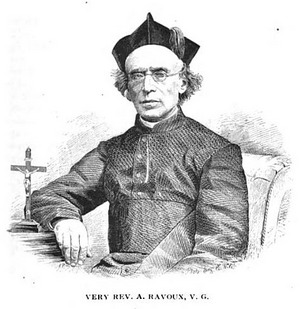
By the 1850s, ideas about race in Minnesota started to match the rest of the U.S. The main leaders were mostly Anglo-American Protestants. Settlers from the U.S. increasingly saw "white" people as key to Minnesota's future. They wanted to limit the role of other groups. Author James Wesley Bond described Minnesota before the 1850s as "a waste of woodland and prairie, uninhabited save by the different hordes of savage tribes."
However, prejudices were complex. In Saint Paul in the 1840s, mixed-race people were often treated equally. Children of all races went to the same schools. But by the late 1840s, black people could not vote. They also could not run for office, and their children went to separate schools. In contrast, Irish Catholics and Native Americans who adopted European ways could vote. Their children were not separated in schools.
Minnesota was a multi-lingual area. Early on, French and English were used a lot. But Ojibwe, Sioux, and Michif (the Métis language) were more common. By the late 1850s, English was the most spoken language. But new immigrants brought more languages. Newspapers were published in German, Swedish, and Norwegian. Irish Gaelic, Czech, and other languages were also used.
Most people in the region earlier followed traditional tribal religions. But Roman Catholicism was known because of French traders. Catholic missionary work grew a lot in the early 1800s. The Catholic Church became strong in Saint Paul. Protestantism was newer. The first Protestant church appeared in 1848 in Saint Paul. The waves of immigrants in the 1850s quickly made Protestants the largest religious group. Leaders tried to attract immigrants from Protestant areas of Northern Europe. This was to ensure Protestant control of the region.
African Americans and Slavery
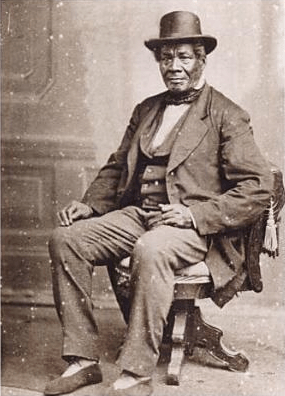
The Northwest Ordinance of 1787 was supposed to outlaw slavery in the Northwest Territory, which included Minnesota. The law said there should be "neither slavery nor involuntary servitude." But it was unclear about slaves already in the territories. French traders and even American army officers continued to hold slaves.
The number of African Americans in the territory was small but important. Newcomers brought slaves. But there were also many free black people. Some worked as servants, and some were independent pioneers. Records from 1850 show 39 free black people out of 6,077 citizens in the territory. This number did not include Native American tribes. Before the 1840s, free black people were often treated equally. But by the time Minnesota became a state, black people could not vote. Their children also went to separate schools. However, from 1848, Minnesota's leaders were mostly against slavery. This helped end the practice in this era.
One famous early African American in the territory was George Bonga. He was born in Minnesota in 1802. His father was the son of a freed slave. His mother was a member of the Ojibwe tribe. Bonga went to school in Montreal. He became a fur trader. He also worked as an interpreter in talks with the Ojibwe. His brother Stephen was an Ojibwe interpreter at Fort Snelling for the 1837 treaty.
In the 1850s, Fort Snelling was important in the famous Dred Scott court case. Slaves Dred Scott and his wife were brought to the fort by their owner. They lived at the fort and in other places where slavery was not allowed. After their owner died, the Scotts argued they should be free. They said they had lived in free territory. In 1857, the U.S. Supreme Court ruled against the Scotts. This decision made tensions over slavery worse. It contributed to the American Civil War.
Government and Becoming a State
In the early 1800s, the area that is now Minnesota was not one single unit. The Mississippi River divided lands claimed by different countries. Even after the Louisiana Purchase, it was a border between territories. The border between U.S. and British territories was unclear until 1818. The Anglo-American Convention of 1818 set the border at the 49th parallel west of the Lake of the Woods. Border disputes east of the Lake of the Woods continued until 1842.
For the first half of the 1800s, northeastern Minnesota was part of the Northwest Territory. After Ohio became a state, it became part of the Illinois Territory in 1809. Then it was part of the Michigan Territory in 1818. Later, it became part of the Wisconsin Territory in 1836. The western and southern parts of Minnesota were not formally organized until 1838. Then they became part of the Iowa Territory.
After Wisconsin became a state in 1848, the Minnesota area was temporarily without a government. John Catlin, a former Wisconsin Territory secretary, claimed to be governor for a short time. By then, most Minnesota residents were Democrats. They hoped Congress, which was controlled by Democrats, would help them. In 1848, a meeting was held in Stillwater. It was called the "Stillwater Convention." They discussed creating a new territory. The participants elected Henry Sibley to represent them in Congress.
Stephen A. Douglas, a Democrat, helped create the bill for the Minnesota Territory in 1848. He wanted to keep the upper Mississippi valley from being divided by other territories. He had stopped Iowa from including Fort Snelling and Saint Anthony Falls in its border. He also stopped Wisconsin from including Saint Paul and Saint Anthony Falls. The Minnesota Territory was created from lands left over from the Iowa Territory and Wisconsin Territory on March 3, 1849. The Minnesota Territory stretched far into what is now North and South Dakota. There was a debate about the shape of the future state. One idea that almost passed would have made the 46th parallel the northern border. This would have given up the northern half of the state.
Alexander Ramsey, a Whig, became the first governor of Minnesota Territory. Henry Hastings Sibley, a Democrat, became the territory's representative in Congress. Henry Mower Rice, a Democrat, replaced Sibley in 1853. He worked in Congress to help Minnesota. He pushed for a railroad connecting Saint Paul and Lake Superior. He also wanted a link from Saint Paul to the Illinois Central Railroad.
Becoming a State
Before 1856, people in Minnesota did not talk much about becoming a state. But when serious talks began about a transcontinental railroad, Minnesota leaders realized territories had less power. They wanted to be a state to get this economic chance.
In December 1856, Rice proposed two bills in Congress. One was an enabling act. This would let Minnesota create a state constitution. The other was a railroad land grant bill. The enabling act defined a state with both prairie and forest lands. Its borders were drawn as they are today. The push for statehood happened when tensions between the North and South were rising in the U.S. These tensions later led to the American Civil War. There was a big debate about letting Minnesota in as a free state. But the enabling act finally passed on February 26, 1857.
A constitutional convention met in the territory in July 1857. There were disagreements between Republicans and Democrats. This led to two separate constitutions being written. The larger cities like Saint Paul, Saint Anthony, and Stillwater were mostly Democratic. Farming areas in southern Minnesota were Republican. They finally agreed on one constitution. But the more powerful Democrats usually got their way. The parties were so angry that two separate copies of the constitution had to be used. This way, members of each party did not have to sign a copy signed by the other party. The copies were signed on August 29, 1857. An election was held on October 13, 1857, to approve the document. 30,055 voters approved it, while 571 rejected it.
The state constitution was sent to the United States Congress in December 1857. The approval process took several months. Congress was debating issues from the Kansas–Nebraska Act. Once questions about Kansas were settled, the bill for Minnesota's statehood passed. The eastern half of the Minnesota Territory became the country's 32nd state on May 11, 1858. The western part remained unorganized. It became part of the Dakota Territory on March 2, 1861.
Minnesota in Popular Culture
In 1855, Henry Wadsworth Longfellow published The Song of Hiawatha. He had never explored Minnesota himself. But his story had many references to Minnesota regions. The story was based on Ojibwe legends. Explorers and traders had brought these stories back east.
Joseph Rolette was a fur trader and politician. He was part Métis. He became a famous figure in Minnesota history for being rebellious. His most famous story is when a bill was passed in 1857. It would have moved the capital from Saint Paul to Saint Peter. Rolette took the bill and hid it. This stopped it from becoming law. This and other stories made Rolette a legend.
Minnesota is known as the "Gopher State" today. This nickname was chosen in the mid-1800s to create an identity for the state. Some thought "Beaver State" would be more dignified. But a political cartoon with a gopher soon made "Gopher State" the more popular name.


